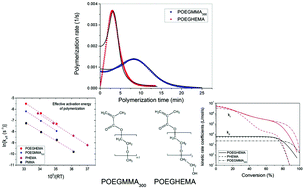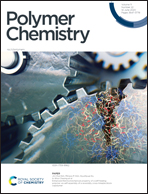Effect of the side ethylene glycol and hydroxyl groups on the polymerization kinetics of oligo(ethylene glycol methacrylates). An experimental and modeling investigation†
Abstract
Polymers based on methacrylates bearing short oligo(ethylene glycol) side parts constitute a modern class of stimuli-responsive, biocompatible materials exhibiting several important biological applications. A study of their polymerization kinetics considering also the effect of functional (such as hydroxyl) groups in the macromolecular chain is very important in order to set the appropriate reaction parameters (such as time, temperature, etc.). The materials investigated were based on oligo(ethylene glycol) methyl ether methacrylate with 4–5 ethylene oxide units, POEGMMA300 and oligo(ethylene glycol) hydroxyethyl methacrylate with nearly 5 ethylene oxide units and a terminal hydroxyl group, POEGHEMA. Experimental data on their bulk radical polymerization were collected under both isothermal and non-isothermal reaction conditions and compared with the corresponding data from polymers without PEG units. An appropriate theoretical model was also developed taking into account the effect of diffusion controlled phenomena on the reaction kinetic rate constants and used to simulate the experimental data over the whole conversion range. From the experimental data the term that combines the kinetic rate coefficients of the propagation and termination reaction, i.e. kp2/kt, was evaluated. It was found that these values increase with the increasing size of the ester group for both POEGMMA300 compared to PMMA and POEGHEMA compared to PHEMA. The presence of the hydroxyl group in POEGHEMA resulted in a higher polymerization rate compared to POEGMMA300. In contrast, verifying similar literature findings, the effective activation energy, as well as the activation energies of the propagation and termination reactions were found not to be significantly affected by the presence of the side groups. Furthermore, the presence of the hydroxyl groups leads to slightly higher critical free volumes for the onset of the gel- and glass-effect, meaning an earlier effect of the diffusion-controlled phenomena on both the termination and propagation reactions. Using appropriate equations correlating all parameters with temperature, the predictive capabilities of the model were tested in non-isothermal runs and the simulation of the experimental data was found to be very good. Depropagation reactions were not found to play a significant role, since all non-isothermal experiments were completed at temperatures less than 120 °C, below the ceiling temperature of the systems.



 Please wait while we load your content...
Please wait while we load your content...